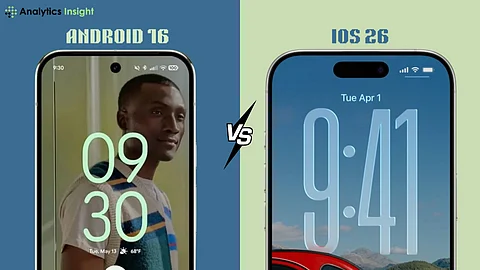

Apple goes bold with iOS 26's Liquid Glass design and deep AI integration through Apple Intelligence.
Android 16 focuses on power and flexibility, bringing pro camera features and advanced multitasking for tablets and foldables.
Users are split—iOS is praised for seamless experience, while Android wins on device choice and customization.
Apple’s iOS 26 features a revolutionary visual transformation known as Liquid Glass. The translucent panels and floating UI elements lend a futuristic, interactive vibe. Icons, widgets, and multitasking controls all have a parallax-style animation with different depth levels.
Android 16, however, continues with a less bold evolution of Google’s Material You, now into the Material 3 Expressive stage. Blur effects, dynamic theming, and improved transitions look like an update without radically changing the user experience.
Apple’s visual refresh is revolutionary; Android’s is polished.
iOS 26 brings generative AI into the daily use case, redrafting messages, summarizing emails, dealing with notifications, and even taking hold calls through Hold Assist. Siri receives context-aware abilities, and Live Translate provides live voice translations in FaceTime and calls.
Android 16’s AI emphasis is less in-your-face. It improves spam call identification, provides Live Updates for services (such as taxis or food delivery), adds AI-based editing options in Photos, and fuels the Gemini assistant in Gmail and Docs.
In brief, Apple emphasizes user-focused personalisation; Android maximizes daily utilities.
Also Read: iPhone 16 Under Rs. 34,000? Amazon Sale Brings Massive Price Cut on Apple’s Flagship
iOS 26’s Messages app has polls, emoji reactions, smart summaries, and voice transcription added to it. The camera benefits from spatial video, lens cleanliness warnings, and manual shot controls, particularly for Vision Pro users.
Android 16, for its part, goes all in on pro-level video features, adding support for the APV codec, UltraHDR, motion capture, night-mode scenes, and hybrid exposure. It also adds desktop-level multitasking on tablets and foldables.
Apple enhances consumer convenience; Android enhances content creators and power users.
Apple modernizes ecosystem security with encrypted logs, Siri offline, and AI models that run on the edge. Recently announced changes to iOS 26 include improvements for Apple Pay, AirPods integration, and family controls.
Meanwhile, iOS 26 users tend to lean toward an appreciation for Apple's polished ecosystem. Much love has been showered upon the Liquid Glass design for its smooth and modern aesthetics; some, however, would concede to the stipulation that it means more battery drain.
The other well-accepted one is Apple Intelligence, Apple's AI layer. Its features, especially the Hold Assist and intelligent message summary features, feel natural and are smoothly embedded in everyday apps.
For the average user, iOS 26 versus Android 16 is a comfortable trade-off between customization and cohesion. Android users like the platform’s flexibility. Android 16 allows them to pick from a broader array of devices, from budget handsets to very affordable and simple models to foldables, and customize almost every interface element to their heart’s content.
Innovations such as desktop-style multitasking on tablets and foldables have also been praised, particularly by professionals who depend on multi-window workflows.
Meanwhile, iOS 26 users appreciate Apple’s polished ecosystem. The fresh Liquid Glass design has wowed many with its smooth and modern aesthetic, although some acknowledge it does come at the expense of heightened battery usage.
Apple Intelligence, Apple’s new AI layer, has also been well accepted, especially features such as Hold Assist and intelligent message summaries, which feel natural and smoothly embedded in day-to-day apps.
Content creators favor Android 16 due to its industry-standard camera APIs and full-featured video support. That said, most people still favor iOS for fast shooting, editing, and overall reliability of the native camera app.
Generally, users will concur on one issue: Android offers greater control and flexibility, while iOS presents a more polished, secure experience, best used with other Apple devices. It’s less of an issue of one OS being objectively superior to the other, and more a case of what OS best suits a user’s online lifestyle and usage.
Choose iOS 26 if you want a radical rethink, more harmony in the integration ecosystem, and highly integrated AI that will help your workflow without getting in your way.
Choose Android 16 for customization, better security, multitasking-oriented behavior (especially on foldables/tablets), and powerful content creation tools.
By the end of the day, both platforms are operating systems and ecosystems. This year, they’re a little more intelligent, personalized, and ambitious than ever.
You May Also Like
Q1. What is the main difference between iOS 26 and Android 16?
iOS 26 focuses on design and ecosystem AI; Android 16 offers customisation, multitasking, and pro tools, especially on foldables and tablets.
Q2. Which OS has better AI features in 2025?
Apple Intelligence offers deep app integration, while Android 16 uses Gemini AI for practical tasks, Apple feels more seamless; Android is more utility-driven.
Q3. Can older devices run iOS 26 and Android 16?
iOS 26 supports iPhone 11 and newer; Android 16 began on Pixel and rolls out gradually to Samsung, OnePlus, Vivo, and others.
Q4. Which OS is better for creators?
Android 16 leads with pro camera APIs, APV codec, and UltraHDR. iOS 26 offers spatial video and AI edits but targets general users more.
Q5. Is iOS 26 better for security?
Both improve security, but iOS 26 emphasizes on-device AI and tighter privacy. Android 16 adds biometric ID, USB lockdown, and fraud detection features.
